The ASUS ZenPad S (Z580CA) Review
by Brandon Chester on August 31, 2015 8:00 AM ESTSystem Performance
A common trend among the tablets I've reviewed in the past few months is that they've used Intel's mobile SoCs rather than the ARM SoCs that you'll see in most tablets and smartphones. All the tablets I've reviewed have come from manufacturers that traditionally made Windows PCs and laptops, and the long-term relationship they would have with Intel is a reasonable explanation as to why they've partnered with Intel for the processors in their tablets. Like both models of the Dell Venue 7000 series, and the top tier model of the ZenFone 2, the ZenPad Z580CA is powered by an Intel Atom Z3580 SoC. This is a quad core Atom part built on Intel's 22nm process, with a max burst frequency of 2.33GHz. In the case of the Z580CA it's paired with 4GB of LPDDR3-1600 memory, which is twice as much as the amount in the Dell Venue tablets.
To evaluate the ZenPad Z580CA's performance I've run it through our standard benchmark suite. The first set is our web benchmarks which is influenced both by a device's browser optimizations as well as its CPU, followed by BaseMark OS II to evaluate several aspects of a device's hardware, and finally PCMark which emulates tasks that a user would perform while actually using a device.
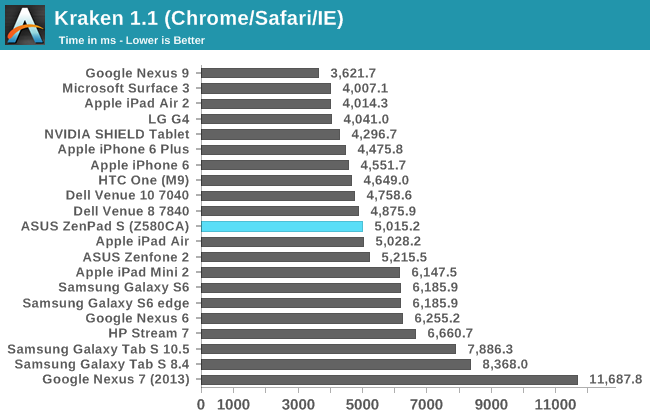
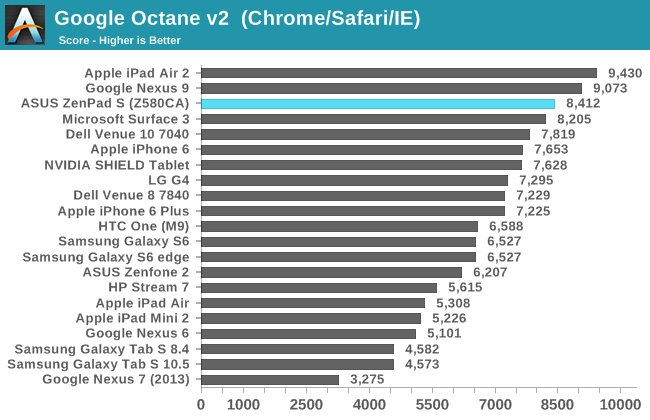

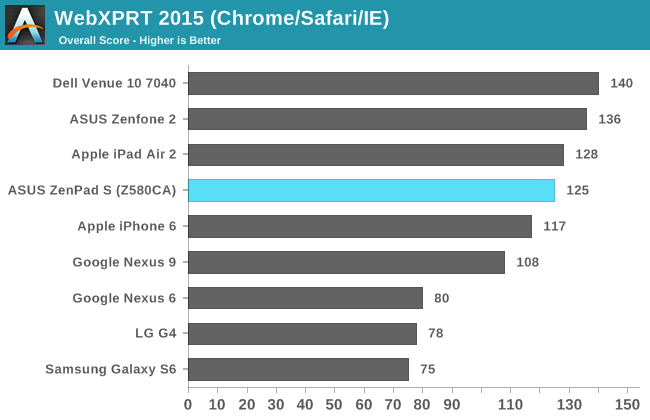
The ZenPad S performs well in our web browser benchmarks. There’s clearly differences at the OS level as well as possible BSP (board support package) differences between the ZenPad and other Intel-based Android devices like the Dell Venue tablets and the ZenFone 2. In Kraken we see a result closer to the middle of our chart, sitting among the Venue 8, Venue 10, ZenFone 2, and Apple’s A7-based iPads. It’s worth noting that as we no longer have those iPads for testing, the results for those devices were performed on iOS 7 and don’t benefit from any enhancements made to Apple’s rendering engine in subsequent releases.
In Google’s Octane benchmark the ZenPad S sits high on the chart with a score that isn’t quite as high as the Nexus 9 or the iPad Air 2, but sitting not far behind. There’s an enormous improvement over the ZenFone 2, and I’m not sure what to attribute this to as both devices use the same hardware platform and both are Android 5.0 underneath ZenUI. Since the test isn’t very long it’s not likely that it has to do with differences in thermal throttling between the two, and most likely is rooted somewhere in the software differences between the ZenFone and the ZenPad.
As for the 2013 and 2015 iterations of WebXPRT, the ZenPad S seems to perform much better in the latter test than it does in the former. While in WebXPRT 2013 it sits behind the iPhone 6 and the Nexus 9, in the 2015 iteration it surpasses both of them. In both cases it’s still behind the iPad Air 2, but for $299 you’re getting a lot of performance for your money.
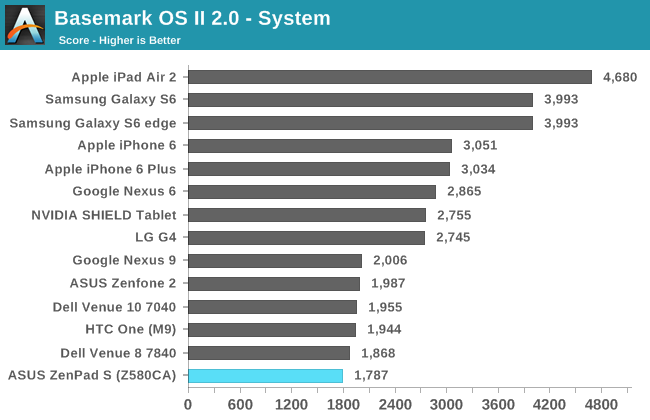
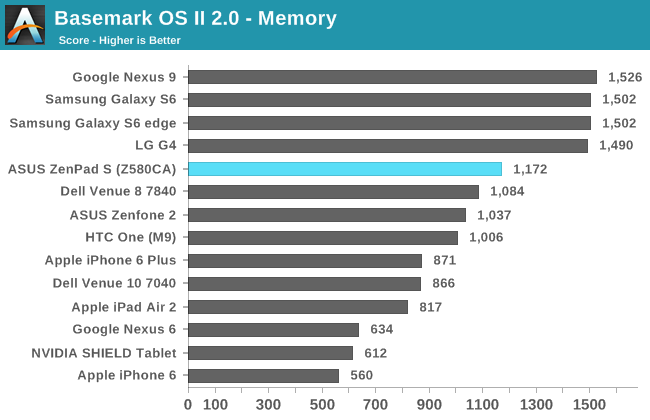
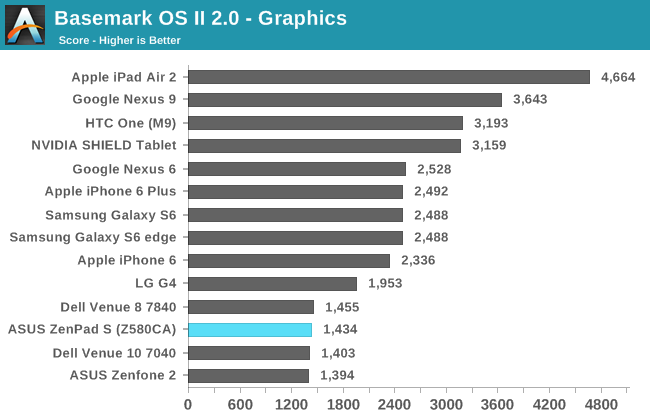

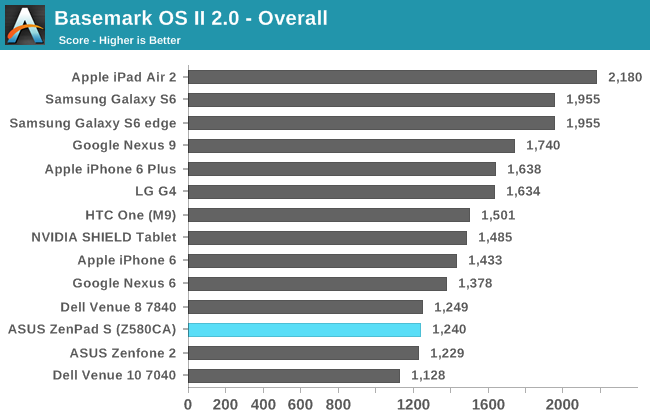
Like all the Intel-based Android devices that I’ve tested, the ZenPad S doesn’t score very high in BaseMark OS II. The score in the graphics sub-test is tied with all the other G6430 devices for last, which says more about how far GPU performance in mobile has come in two years rather than the ZenPad S simply being slow. The score in the system sub-test which stresses the CPU and RAM is the lowest on the chart. In the end all Intel Atom devices don’t perform well in BaseMark OS II, but when a device is $199 like the ZenFone 2 or $299 like the ZenPad S Z580CA I think the performance that the Atom SoC provides is more than sufficient.
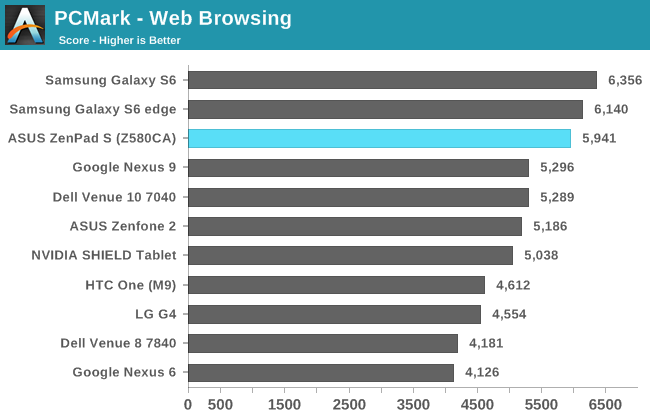
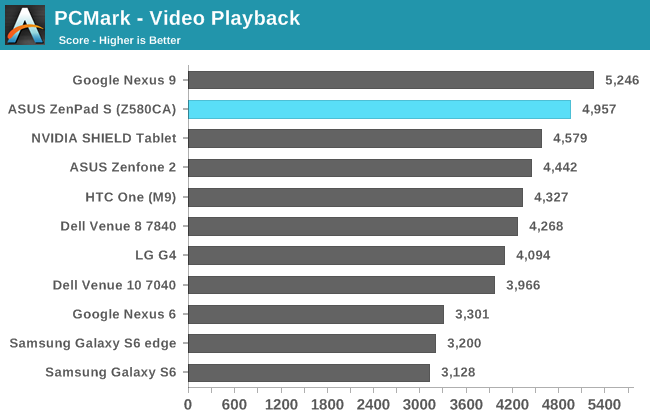

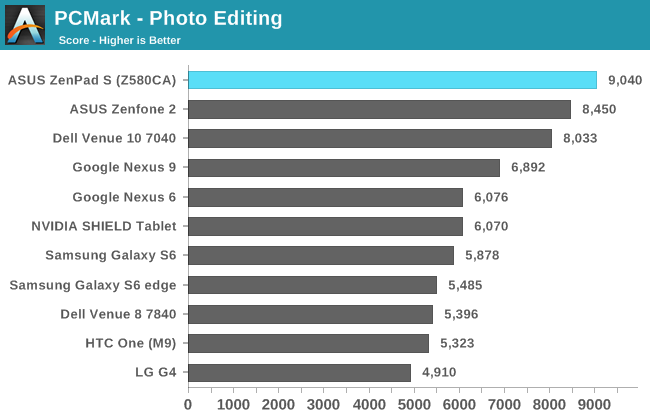

Our final test is PCMark, which emulates tasks that users will perform in the real world like browsing the web, playing and seeking videos, editing photos, and more. The ZenFone 2 performed very well in PCMark, but it ended up being carried to an extent by a disproportionately high photo editing score. The ZenPad S takes this even further with a higher photo editing score, and ends up taking the top spot in the overall ranking. There’s definitely a large software influence in these tests, which isn’t unlike the real world performance that is being tested, which requires both good hardware and optimized software to provide good performance. That being said, I think the ZenPad S ranking first on the basis of its extremely high photo editing score is a little bit questionable, but even without that test it would still score highly overall.
My conclusions about the system performance of the ZenPad S Z580CA are not unlike those in my ZenFone 2 review. When a device is $199 or $299, Intel’s Atom Z580CA SoC is faster than any ARM-based Android device at that price. PCMark doesn’t support iOS, and so there’s no way to know how well the ZenPad S compares to the iPad Mini 2 outside of web performance, but based on the JavaScript benchmark results it’s clear that the ZenPad S should be competitive with it, if not faster.










114 Comments
View All Comments
kmmatney - Monday, August 31, 2015 - link
Having both a 16:9 windows tablet and an iPad, IMO 4:3 is better. Who plays "immersive" games on there tablet? - that's what a computer or laptop is for. For typical things you use a tablet for - web browsing, reading emails, reading books, you tube, various other consumption, the 4:3 aspect ratio is perfect. I don't pretend to do any serious work on my tablets, but I wish my windows tablet was 4:3. There is a reason why the MS Surface tablets no longer use a 16:9 aspect ratio.boeush - Monday, August 31, 2015 - link
This is getting pretty stupid... Let's say your tablet is x inches long. Does it really make that much difference whether it's height gives 19:10 ot 4:3 AR? Unlike a phone, you aren't about to shove that tablet into a pocket. So is it REALLY so TERRIBLE that you have extra vertical screen space when watching a movie in landscape? Yeah, instead of that extra screen you could just have empty space I guess - but that still won't make your tablet all that more compact anyway (with the horizontal dimension being dominant.) So boo-hoo, you get top and bottom sidebars on your video. Contrast that with the use cases where you need/want that extra height in your landscape mode, or the extra width in portrait - and DON'T HAVE IT because your tablet is built oblong and that's that. Seriously, I for one would rather have extra screen space I don't need under certain circumstances, rather than at other times needing the extra space and not having it!keltypack - Monday, August 31, 2015 - link
I totally agree with the 4:3 aspect ratio. I don't know what people are thinking, but a tablet is a GREAT way to watch a movie on an airplane. The 16:9 ratio is much better for reading books. I don't understand the Apple fascination with 4:3. To be fair, I think 3:2 is a better aspect ratio than 16:9, but maybe that is the old-school photographer in me.uhuznaa - Monday, August 31, 2015 - link
16:9 sucks for websites and more compley apps though, both in portrait (too narrow) and in landscape (with some toolbars around you see only a small sliver and when typing into a form there's hardly any content left).But yes, if you're mainly watching movies with your tablet, 16:9 is better.
sonny73n - Tuesday, September 1, 2015 - link
The only reason 16:9 is better for movies because all HD contents are in 16:9. But to me, 16:9 is just odd and stupid. I remember when the first wave of HDTV hit the market, there was a widescreen trend. So bad they even started making movies wider than 16:9 - something really odd like 1920x818 instead of the 1920x1080.16:9 is horrible even on phones. Keyboard in landscape mode blocks more than 50% of the screen. You can have a 4.7in 1280x768 screen looks as big as a 5in 1280x720. 16:9 sucks, movies too. I'd rather see movies in 2:3 format.
BurntMyBacon - Wednesday, September 2, 2015 - link
@sonny73n: 16:10 more accurately maps to the active area of the human visual system and thus gives a more immersive experience at the appropriate screen size / viewing distance. 16:9 was just cost cutting measure by reducing the probability of defects in a screen given the statistical probability of localization. Problem is, you can't interact with your tablet when it's in your face. Most people don't sit that close to a TV either. Usability on 16:9 isn't very good. It is better at 16:10, but 4:3 or 3:2 can make more sense in a lot of cases. I personally prefer 16:10 (1280x800 in your example above), but a lot of that depends on how the tools you use are laid out.R. Hunt - Tuesday, September 1, 2015 - link
Apps look so much more natural in 4:3 IMO. Web browsing, and PDF reading are also better. I think, specially for large tablets, a squarer aspect ratio is overall the better choice. My Tab Pro 10.1 looks and feels really awkward in portrait (and unnecessarily long). I'll be getting the Tab S2 soon, no doubt.BurntMyBacon - Wednesday, September 2, 2015 - link
@keltypack: Yes. Your 3:2 preference is the old school photographer in you. Nothin wrong with that.retrospooty - Monday, August 31, 2015 - link
jjj, I think you need to put the pipe down.Puck85 - Thursday, September 10, 2015 - link
serious question: what should I buy instead of this around this price range?